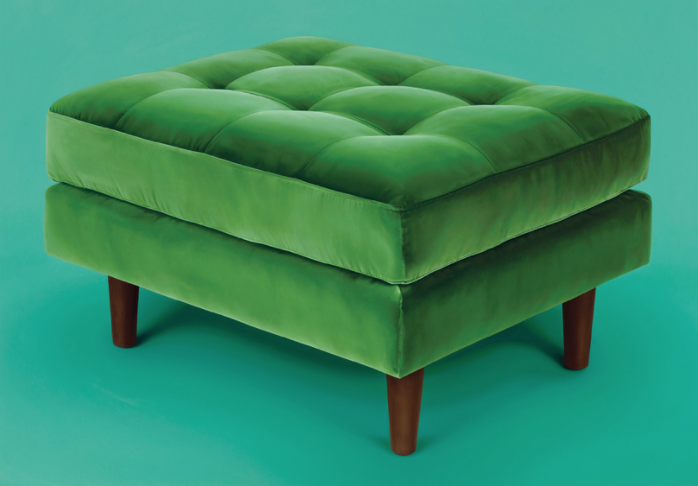March 2021
Download as PDF
View on Artforum

Mathew Cerletty, Ottoman, 2020, oil on linen, 48 × 70″.
Mathew Cerletty’s airless, photorealistic paintings of mundane consumer goods exude the seemingly anonymous nature of all possessions. Yet the things depicted in this exhibition—including a looped leather belt, a yellow rubber duckie, a clothes-drying rack, and a furry stuffed animal—become talismans of incarnate presence through the artist’s ruthless attention to detail, his almost preternatural skill, and their unnervingly front-and-center journalistic presentation.
In Snow Shovel, 2019, Cerletty features the titular object standing upright on an icy bank. The tool’s rocket-red handle grip and blade contrast vividly with a luminous, gradated sky of lavender and pale rose. The inert shovel feels anthropomorphized—likely due to the artist’s exacting, even loving, portrayal. Oddly, the image calls to mind a classic of regionalist art: Grant Wood’s American Gothic, 1930. The air of sobriety and straightforwardness that permeates Wood’s famous portrait of a farm couple (and their iconic pitchfork) lines up remarkably well with Cerletty’s painting of a shovel. While both objects are severe and steadfastly vertical in pictorial orientation, they also illustrate a spectrum of labor across the twentieth century: from hard agricultural graft with sharp metal tools to suburban tasks performed with an implement built from cheap wood and light plastic.
One also senses that Cerletty has subtly recontextualized his fastidious interpretations of dull, store-bought items for the Covid-19 era, particularly in the way one interfaces with these things during the anxious isolation of quarantine. Take Ottoman, 2020, which suggests the dual capacity of objects to comfort and confine. The footstool—plush, oversize, and green—seems like the kind of appointment you’d find in a therapist’s office to gently rest your feet on as the doctor calmly takes in your every word. But the garish teal space the item sits in is oddly pharmaceutical—the color of an old hospital gown or a bitter pill. Cerletty, like late painter Robert Bechtle—whose deadpan pictures of nuclear families and cul-de-sacs radiate a subtle, unsettling magic—can transform the dumbest of objects and plainest of settings into moments of deep uncanniness. But Cerletty also highlights how our lives are inundated with base, commercial stuff—we’re bombarded by the advertising machine that insists our lives will be improved if we would just buy, buy, buy. Whether we’re minimalists or inveterate collectors, Cerletty’s paintings imply that we assert our value and define our sensibilities by what we choose to live with.
Yet above all else Cerletty is a rigorous observer who has a deep connection to representational painting and its illusionistic strangeness. Consider Manila Envelopes, 2020, in which a pair of the office items—one recto, one verso—appear delicately bathed in light. The clever compositional relationship between the two figures highlights the complex and sometimes contradictory nature of perception. The envelope in the foreground, with its back facing us, is reduced to a flat, floating rectangle; it reads as an almost nonobjective shape. It produces a drop shadow on the envelope hovering behind it, whose flap is open and whose metal closure is visible. The artist plays a visual game that makes us seesaw between realism and abstraction, space and nonspace. Like all the other works in the show, Manila Envelopes is deeply unsentimental, yet it possesses the gravitas and wonder of a trompe l’oeil letter-board painting from the seventeenth century.
The title of Cerletty’s exhibition, “Full Length Mirror,” indicates that the artist wants us to see ourselves reflected in these deceptively unassuming portraits of everyday objects. But he also asks us to scrutinize them closely in order to locate and appreciate the unique qualities inherent in each one.



